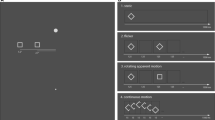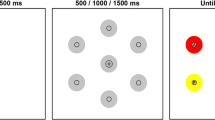Abstract
Temporal gaps between the offset of a central fixation stimulus and the onset of an eccentric target typically reduce saccade latencies (saccadic gap effect). Here, we test whether temporal gaps also affect perceptual performance in peripheral vision. In Experiment 1, subjects executed saccades to briefly presented peripheral target letters and reported letter identity afterwards. A central fixation stimulus either remained visible throughout the trial (overlap) or disappeared 200 ms before letter onset (gap). Experiment 2 tested perceptual performance without saccade execution, whereas Experiment 3 tested saccade execution without perceptual demands. Peripheral letter perception performance was enhanced in gap as compared to overlap conditions (perceptual gap effect) irrespective of concurrent oculomotor demands. Furthermore, the saccadic gap effect was modulated by concurrent perceptual demands. Experiment 4 ruled out a general warning explanation of the perceptual gap effect. These findings extend recent theories assuming a strong coupling between the preparation of goal-directed saccades and shifts of visual attention from the spatial to the temporal domain.


Similar content being viewed by others
References
Allport DA (1987) Selection for action: some behavioral and neurophysiological considerations of attention and action. In: Heuer H, Sanders AF (eds) Perspectives on perception and action. Lawrence Erlbaum, Hillsdale, pp 395–419
Beauchamp MS, Petit L, Ellmore TM, Ingeholm J, Haxby JV (2001) A parametric fMRI study of overt and covert shifts of visuospatial attention. NeuroImage 4:310–321
Bekkering H, Pratt J, Abrams RA (1996) The gap effect for eye and hand movements. Percept Psychophys 58:628–635
Bell AH, Everling S, Munoz DP (2000) Influence of stimulus eccentricity and direction on characteristics of pro- and antisaccades in non-human primates. J Neurophysiol 84:2595–2604
Broadbent DE (1958) Perception and communication. Oxford University Press, New York
Castiello U (1996) Grasping a fruit: selection for action. J Exp Psychol Hum Percept Perform 22:582–603
Clark JJ (1999) Spatial attention and latencies of saccadic eye movements. Vis Res 39:585–602
Corbetta M, Akbudak E, Conturo TE, Snyder AZ, Ollinger JM, Drury HA, Linenweber MR, Petersen SE, Raichle ME, Van Essen DC, Shulman GL (1998) A common network of functional areas for attention and eye movements. Neuron 21:761–773
Craighero L, Rizzolatti G (2005) The premotor theory of attention. In: Itti L, Rees G, Tsotsos JK (eds) Neurobiology of attention. Elsevier, San Diego, pp 181–195
Craighero L, Fadiga L, Rizzolatti G, Umiltà C (1999) Action for perception: a motor-visual attentional effect. J Exp Psychol Hum Percept Perform 25:1673–1692
De Haan B, Morgan PS, Rorden C (2008) Covert orienting of attention and overt eye movements activate identical brain regions. Brain Res 1204:102–111
Desimone R, Wessinger M, Thomas L, Schneider W (1989) Effects of deactivation of lateral pulvinar or superior colliculus on the ability to selectively attend to a visual stimulus. Soc Neurosci Abs 15:162
Deubel H, Schneider WX (1996) Saccade target selection and object recognition: evidence for a common attentional mechanism. Vis Res 36:1827–1837
Deubel H, Schneider WX, Paprotta I (1998) Selective dorsal and ventral processing: Evidence for a common attentional mechanism in reaching and perception. Vis Cogn 5:81–107
Dorris MC, Munoz DP (1995) A neural correlate for the gap effect on saccadic reaction times in monkey. J Neurophysiol 73:2558–2562
Eimer M, van Velzen J, Gherri E, Press C (2006) Manual response preparation and saccade programming are linked to attention shifts: ERP evidence for covert attentional orienting and spatially specific modulations of visual processing. Brain Res 1105:7–19
Eimer M, van Velzen J, Gherri E, Press C (2007) ERP correlates of shared control mechanisms involved in saccade preparation and in covert attention. Brain Res 1135:154–166
Eriksen CW (1995) The flankers task and response competition: a useful tool for investigating a variety of cognitive problems. Vis Cog 2:101–118
Findlay JM, Gilchrist ID (2003) Active vision: the psychology of looking and seeing. Oxford University Press, Oxford
Fischer B, Weber H (1993) Express saccades and visual attention. Behav Brain Sci 16:553–610
Henderson JM (1992) Visual attention and eye movement control during reading and scene perception. In: Rayner K (ed) Eye movements and visual cognition. Springer, New York, pp 260–283
Hoffman JE, Subramaniam B (1995) The role of visual attention in saccadic eye movements. Percept Psychophys 57:787–795
Ignashchenkova A, Dicke PW, Haarmeier T, Thier P (2004) Neuron-specific contribution of the superior colliculus to overt and covert shifts of attention. Nat Neurosci 7:56–64
Juan C-H, Muggleton N, Hung D, Tzeng O, Cowey A, Walsh V (2008) Segregation of visual selection and saccades in human frontal eye fields. Cereb Cortex 18:2410–2415
Kapoula Z, Robinson DA (1986) Saccadic undershoot is not inevitable: saccades can be accurate. Vis Res 26:735–743
Khan AZ, Blangero A, Rossetti Y, Salemme R, Luauté J, Deubel H, Schneider WX, Laverdure N, Rode G, Boisson D, Pisella L (2009) Parietal damage dissociates saccade planning from pre-saccadic perceptual facilitation. Cereb Cortex 19:383–387
Kingstone A, Klein RM (1993) Visual offsets facilitate saccadic latency: does predisengagement of visuospatial attention mediate this gap effect? J Exp Psych Hum Percept Perform 19:1251–1265
Klein RM (1980) Does oculomotor readiness mediate cognitive control of visual attention? In: Nickerson R (ed) Attention and performance VIII. Erlbaum, Hillsdale, pp 259–276
Kowler E, Anderson E, Dosher B, Blaser E (1995) The role of attention in the programming of saccades. Vis Res 35:1897–1916
Kustov AA, Robinson DL (1996) Shared neural control of attentional shifts and eye movements. Nature 384:74–77
MacKeben M (1999) Sustained focal attention and peripheral letter recognition. Spat Vis 12:51–72
MacKeben M, Nakayama K (1993) Express attentional shifts. Vis Res 33:85–90
Moore T, Armstrong KM (2003) Selective gating of visual signals by microstimulation of frontal cortex. Nature 421:370–373
Moore T, Fallah M (2004) Microstimulation of the frontal eye field and its effects on covert spatial attention. J Neurophysiol 91:152–162
Nakayama K, Mackeben M (1989) Sustained and transient components of focal visual attention. Vis Res 29:1631–1647
Neumann O (1987) Beyond capacity: a functional view of attention. In: Heuer H, Sanders AF (eds) Perspectives on perception and action. Erlbaum, Hillsdale, pp 361–394
Nobre AC, Gitelman DR, Dias EC, Mesulam MM (2000) Covert visual spatial orienting and saccades: overlapping neural systems. Neuroimage 11:210–216
Ohlendorf S, Kimmig H, Glauche V, Haller S (2007) Gaze pursuit, ‘attention pursuit’ and their effects on cortical activations. Eur J Neurosci 26:2096–2108
Pashler H (1998) The psychology of attention. MIT Press, Cambridge
Peterson MS, Kramer AF, Irwin DE (2004) Covert shifts of attention precede involuntary eye movements. Percept Psychophys 66:398–405
Posner MI (1980) Orienting of attention. Q J Exp Psychol 32:3–25
Pratt J, Nghiem T (2000) The role of the gap effect in the orienting of attention: evidence for express attentional shifts. Vis Cogn 7:629–644
Pratt J, Bekkering H, Leung M (2000) Estimating the components of the gap effect. Exp Brain Res 130:258–263
Pratt J, Lajonchere CM, Abrams RA (2006) Attentional modulation of the gap effect. Vis Res 46:2602–2607
Reuter-Lorenz P, Hughes HC, Fendrich R (1991) The reduction of saccadic latency by prior offset of the fixation point: an analysis of the gap effect. Percept Psychophys 49:167–175
Rizzolatti G, Riggio L, Dascola I, Umilta C (1987) Reorienting attention across the horizontal and vertical meridians: evidence in favor of a premotor theory of attention. Neuropsychologia 25:31–40
Rizzolatti G, Riggio L, Sheliga BM (1994) Space and selective attention. In: Umilta C, Moscovitch M (eds) Attention and performance XV. MIT Press, Cambridge, pp 231–265
Rolke B (2008) Temporal preparation facilitates perceptual identification of letters. Percept Psychophys 70:1305–1313
Rosen AC, Rao SM, Caffarra P, Scaglioni A, Bobholz JA, Woodley SJ, Hammeke TA, Cunningham JM, Prieto TE, Binder JR (1999) Neural basis of endogenous and exogenous spatial orienting: a functional MRI study. J Cogn Neurosci 11:135–148
Ross LE, Ross SM (1980) Saccade latency and warning signals: stimulus onset, offset, and change as warning events. Percept Psychophys 27:251–257
Saslow MG (1967) Effects of components of displacement-step stimuli upon latency for saccadic eye movement. J Opt Soc Am 57:1024–1029
Schneider WX (1995) VAM: A neuro-cognitive model for visual attention control of segmentation, object recognition and spacebased motor actions. Vis Cogn 2:331–376
Schneider WX, Deubel H (2002) Selection-for-perception and selection-for-spatial-motor-action are coupled by visual attention: a review of recent findings and new evidence from stimulus-driven saccade control. In: Prinz W, Hommel B (eds) Attention and performance XIX: common mechanisms in perception and action. Oxford University Press, Oxford, pp 609–627
Schneider W, Shiffrin RM (1977) Controlled and automatic human information processing: 1. Detection, search, and attention. Psychol Rev 84:1–66
Shafiq R, Stuart GW, Sandbach J, Maruff P, Currie J (1998) The gap effect and express saccades in the auditory modality. Exp Brain Res 118:221–229
Sheliga BM, Riggio L, Rizzolatti G (1995) Spatial attention and eye movements. Exp Brain Res 105:261–275
Shepherd M, Findlay JM, Hockey RJ (1986) The relationship between eye movements and spatial attention. Q J Exp Psychol 38A:475–491
Smith DT, Rorden C, Jackson S (2004) Exogenous orienting of attention depends upon the ability to execute eye movements. Curr Biol 14:792–795
Song J-H, Nakayama K (2007) Fixation offset facilitates saccades and manual reaching for single but not multiple target displays. Exp Brain Res 177:223–232
Spence C, Driver J (1996) Audiovisual links in endogenous covert spatial attention. J Exp Psychol Hum Percept Perform 22:1005–1030
Sperling G (1960) The information available in brief visual presentations. Psychol Monogr 74:1–28
Story GW, Carpenter RHS (2009) Dual LATER-unit model predicts saccadic reaction time distributions in gap, step and appearance tasks. Exp Brain Res 193:287–296
Tam WJ, Stelmach LB (1993) Viewing behaviour: ocular and attentional disengagement. Percept Psychophys 54:211–222
Taylor T, Kingstone AF, Klein RM (1998) Visual offsets and oculomotor disinhibition: endogenous and exogenous contributions to the gap effect. Can J Exp Psychol 52:192–200
Tipper SP, Lortie C, Bayliss GC (1992) Selective reaching: evidence for action centered attention. J Exp Psychol Hum Percept Perform 18:891–905
Treisman A (1988) Features and objects: the fourteenth Bartlett memorial lecture. Q J Exp Psychol 40:201–237
Van der Heijden AHC (1992) Selective attention in vision. Routledge, London
Van der Lubbe RHJ, Neggers SFW, Verleger R, Kenemans JL (2006) Spatiotemporal overlap between brain activation related to saccade preparation and attentional orienting. Brain Res 1072:133–152
Wurtz RH, Mohler CW (1976) Organization of monkey superior colliculus: enhanced visual response of superficial layer cells. J Neurophysiol 39:745–765
Acknowledgment
We thank Elena Zettelmeyer for data collection, Ralph Radach for his involvement in developing the paradigm, three anonymous reviewers for their helpful comments on earlier drafts of the manuscript and those who kindly volunteered to participate in the study.
Author information
Authors and Affiliations
Corresponding author
Rights and permissions
About this article
Cite this article
Huestegge, L., Koch, I. Fixation disengagement enhances peripheral perceptual processing: evidence for a perceptual gap effect. Exp Brain Res 201, 631–640 (2010). https://doi.org/10.1007/s00221-009-2080-2
Received:
Accepted:
Published:
Issue Date:
DOI: https://doi.org/10.1007/s00221-009-2080-2




